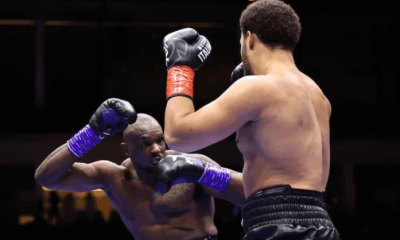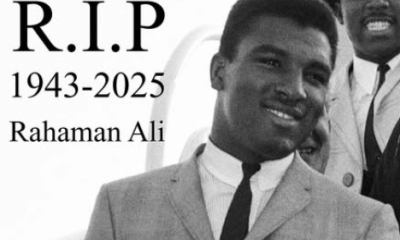Articles of 2006
Joe Liebling’s Sweet Science
One of the most famous observations written about this sport and the connection between its practitioners and their forefathers first appeared in 1956 in the introduction of a book of collected essays on then-modern day pugilism: “The sweet science is joined onto the past like a man’s arm is to his shoulder.” This observation, completely accurate, applies to boxing writers as well who, like the keenest genealogist, trace their inspirations and influences. The writer who influenced and still influences me most is Thomas Hauser whose Brutal Artistry I first read about four years ago. Since then, I’ve read, printed and kept every article of his that has appeared on the Seconds Out website. Indeed, it has been a source of pride to me that my first writing about boxing appeared on the same website as Mr Hauser. Brutal Artistry was not the first book about boxing I ever read, however, as that honor, dubious or otherwise, should be directed towards Geoffrey Beattie’s On the Ropes which I believe is the greatest book ever written about the world that boxing exists in and the gutter that it cannot crawl out of. But Hauser is not only a better writer of boxing than Beattie, he is more prolific, so it is from him that I received my education in the literature of the sport, having been led from him to Hugh McIlvanney and McIlvanney on Boxing, Donald McRae’s Dark Trade, Joyce Carol Oates’s On Boxing and David Remnick’s King of the World among others. The best modern boxing writing now is on the web and I am glad to now be part of that at www.thesweetscience.com.
And eventually in my education I came to Abbott Joseph ‘Joe’ Liebling and The Sweet Science, the introduction of which I have purloined for the opening of this piece. Liebling is the grandfather in the family tree of the twentieth-century boxing writer, the man who brought literary method to what was perceived as hack writing, a subject unworthy of serious merit. In short, he brought elegance to a brutal art and demonstrated that it was form, not subject that distinguished literature from mere copy.
A.J. Liebling was born in 1904 to an aspiring middle-class family in Manhattan. His parents were Jewish but any trace of Yiddish heritage or ancestry was phased quickly from the home. A European sensibility and outlook was quickly engendered in the young Liebling from the procession of German employees that would mark and influence the course of his progression from an obsessed child who sat on his father’s lap reading newspapers to a man, forty years later, critiquing the same.
Liebling’s family may have been Austrian-American but his family were firmly allied with the ethic of the latter. His father, a poor immigrant from Austria had made his money as a furrier and married into a well-off family. While the Lieblings lived the American Dream, they looked back to the old European world and European culture, creating a division in their scion that drew him toward the modern urban landscape of Jazz Age America, in particular New York, yet gave him a European (particularly French) predilection for fine writing, fine culture and, especially, fine food.
As a teenager, Liebling was no athlete; rather, he was the adolescent who while no good at sports could write better and more convincingly about them than anybody else.
In 1920, he went to Dartmouth College from which he was soon expelled from being absent for one religious service too many. That was the reason that became part of the Liebling legend, anyway; the truth of Liebling being booted may have been more mundane – possibly skipping the classes that he hated. Liebling was a great writer but never a wholly truthful one, illustrated by his later occasional quotations of words never spoken so it’s more than possibly, probably likely, that the chapel story was a fabrication. He transferred to the School of Journalism at the University of Columbia, hated it there was well and spent his time there studying the language of France and translating its erotica.
After Columbia, he worked briefly for the Evening World in Providence, Rhode Island in the paper’s sports department before being fired for naming “Ignoto” (Italian for “unknown”) as the referee in a series of basketball games. He was beginning work for another paper, The Journal, again in Providence, when his father stepped in with an offer of a year’s financed study at the Sorbonne in Paris.
Paris, which became a homecoming for the young man, was a city that meshed firmly with Liebling’s European outlook and sensibility although he remained a firm native of New York until his dying day. In the French capital, he began to indulge in his greatest passion – food, which was to both enrich his life, forming a lot of his writing, and ultimately shorten it. France, particularly Paris, was the centre of the world’s culture in the mid-1920s. The Lost Generation, headed haphazardly by Hemingway and Fitzgerald had recently made their home there following the Great War. The city, it seemed was an isle of forward thinking in a world that had recently flung itself into Hell; a place where the greatest literary innovators of the twentieth century both recoiled and recovered from the lunacy of 1914-8 while at the same time sought to understand the ills that had brought it about.
Liebling returned in 1927 and began writing for the same Journal he had left fifteen months earlier. He wanted to write for the Joseph Pulitzer’s World and began campaigning for a spot on the prestigious “writer’s” paper which culminated in the him hiring an unemployed sailor to parade outside the World offices with the words Hire Joe Liebling painted on a sandwich board. The concept, meant to impress the city editor James Barrett, did little to move its intended target towards offering employment with the paper; however another editor took note of some of the work Liebling had sent in and offered him the chance of becoming a freelance features writer.
Liebling stayed at the World for eight years, leaving in 1935 to join The New Yorker, where he stayed for the rest of his life, a period of twenty-eight years. He sparred professionally across the pages and in real life with Joseph Mitchell, his friend and close colleague from the World who had joined The New Yorker in 1938. They explored the world of New York together, poles apart in personality and craft but both firm dwellers of the Big Apple, forever approaching the city with European outlooks.
In 1939, he was sent back to Europe by his editor Harold Ross to cover the war. The New Yorker’s French correspondent had been unable to work because of a family crisis; Liebling stepped in, probably motivated by a desire to be present at the liberation of his favorite city after New York. During his brief time as a war correspondent, he accompanied the Allies to Paris, Algeria and Tunisia. As France was liberated, he rode through the streets of Paris, simultaneously rejoicing and taking notes. In hindsight, his writings of the time were predictably titled The Road Back to Paris when later collected in book form. Liebling had returned to Paris, and Paris had returned to itself. All was well, and even better later on when the French Government bestowed the Cross of the L?gion d’honneur on Liebling for his wartime reporting.
The Sweet Science was originally published in 1956, although Liebling had been writing about boxing since the early 1930s and the particular essays that make up this volume first began appearing in The New Yorker from 1951. Liebling didn’t invent the titular term – that honour goes to his hero, his own forebear, Pierce Egan of Boxiana fame – but he popularised it. For Liebling, boxing was exactly that – a science of feints and twists, bluffs and power, instinct and wisdom; a viewpoint that explains why he was drawn to Archie Moore, the then-light-heavyweight champion of the world and boxing’s old master. Moore is not the only fighter that Liebling chronicles: Marciano, Patterson and Robinson are also significant figures. The smaller fighters aren’t ignored either as Liebling chronicles their fights in pieces such as “Other Fronts.”
The writing is, for want of a better word, astounding; the literary equivalent of the feeling of being blanketed in warm silk. Liebling elevates the sport and its practitioners by not translating their lives as an overarching grand narrative, but by describing them as they go about the day-to-day business of big fights and the preparing for them. At the same time, he deftly makes accurate and concise observations about aspects of the sport.
The Sweet Science has its faults. Liebling was a man and writer of his time, and the language of his work reflects that. A lot of the language concerned with ethnic variation raises a judder in the shoulder when read fifty years on. But Liebling was not a racist – his politics were orientated to the left as he railed against HUAC and supported Alger Hiss. But the language used is the language of 1956, and the vocabulary in the book reflects that. What is more troubling however is Liebling’s denial of pugilistica dementia, the medical condition that’s known more generally known as “punch-drunk” syndrome. Bizarrely, Liebling attempts to disprove its existence by using Ernest Hemingway as an example of an intellect unaffected by blows to the head. But Hemingway was not a career boxer and apparently the likes of Billy Fox never entered Liebling’s orbit. Maybe he would have relented in this view later on if he had ever seen the results apparent in Jerry and Mike Quarry, Wilfred Benitez or Jack Dempsey. Even Joe Louis, the greatest of the greats, couldn’t escape the inevitable mental fog resultant of his profession.
Norman Mailer, an uncritical acolyte of Muhammad Ali, a writer described by Mark Kram in Ghosts of Manila as a ‘tough guy manqué,’ said of Liebling that “When it came to fighters, [he] did have a New Yorker attitude which was fatal,” and made him only able to see his subjects from the outside, unable to relate to them as people rather than characters. But, Mailer it seems is missing the point – The Sweet Science is not about boxers but about boxing. Liebling isn’t concerned with fighters as people, but rather as cogs of the machinery that makes the fight game. His writings on pugilism are the work of what Allen Barra called “… the greatest boxing writer for people who didn’t go to fights.”
The Sweet Science is unquestionably a product of and about its time. The period Liebling covers has, for better and worse, disappeared, changed almost beyond recognition. The business of boxing is no longer controlled solely by the grizzled and tough world-weary managers that populate the volume as the balance of power has now shifted and it is largely boxers, particularly the successful ones, and promoters who have the power in the fight game. And where the managers of 1956 ran a stable of fighters, now it is the fighters who include managers and trainers as part of their stable. The importance of the live gate in large events has also diminished, if not rendered entirely extinct, by the onset of pay-per-view and world championships are often claimed by four or more champions rather than one. Boxing, along with everything else, has changed since 1956.
But the writing remains, if not compelling, then exquisitely crafted. Hack journalists and people who call themselves “writers” can churn out copy, but not many stand the test of time like Liebling and The Sweet Science. It’s why a generation of journalists grew up worshipping Liebling, it’s why any serious writer expounding on boxing possesses and reads The Sweet Science and its sister volume A Neutral Corner and it’s why Sports Illustrated voted The Sweet Science the “Greatest Sports Book of All Time” in 2002.
As for Liebling, he spent his final years before his death in 1963 in relatively happy times. He married for a third time 1959 to the writer Jean Stafford after failed marriages to Anne McGinn, a schizophrenic, in 1936 and Lucille Spectorsky in 1949. In the same year, he began work on a series of columns which became The Earl of Louisiana, his political masterpiece that was published in book form in 1961, closely followed by Between Meals, another masterpiece, this time a memoir of food and France.
He died two years later at the age of fifty-nine, an early death brought on by a lifetime of gluttonous consumption. Heart and liver ailments plagued him, exacerbated by his obesity. He writing output, once prodigious, had begun to fade by this time. He died thinking of France.
-

 Featured Articles4 weeks ago
Featured Articles4 weeks agoThe Hauser Report: Zayas-Garcia, Pacquiao, Usyk, and the NYSAC
-

 Featured Articles3 weeks ago
Featured Articles3 weeks agoOscar Duarte and Regis Prograis Prevail on an Action-Packed Fight Card in Chicago
-

 Featured Articles2 weeks ago
Featured Articles2 weeks agoThe Hauser Report: Cinematic and Literary Notes
-

 Book Review2 weeks ago
Book Review2 weeks agoMark Kriegel’s New Book About Mike Tyson is a Must-Read
-

 Featured Articles4 weeks ago
Featured Articles4 weeks agoRemembering Dwight Muhammad Qawi (1953-2025) and his Triumphant Return to Prison
-

 Featured Articles6 days ago
Featured Articles6 days agoMoses Itauma Continues his Rapid Rise; Steamrolls Dillian Whyte in Riyadh
-

 Featured Articles3 weeks ago
Featured Articles3 weeks agoRahaman Ali (1943-2025)
-

 Featured Articles3 weeks ago
Featured Articles3 weeks agoTop Rank Boxing is in Limbo, but that Hasn’t Benched Robert Garcia’s Up-and-Comers













